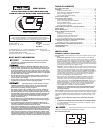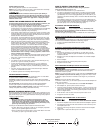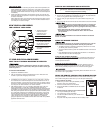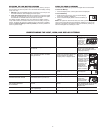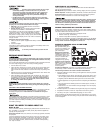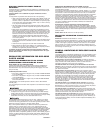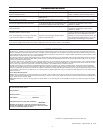
HOW CAN I PROTECT MY F
AMILY FROM CO
POISONING?
A Gas/CO Alarm is an excellent means of pr
otection. It monitors the air and
sounds a loud alarm befor
e Carbon Monoxide levels become threatening for
average, healthy adults.
A Gas/CO Alar
m is not a substitute for proper maintenance of home
appliances.
T
o help prevent CO problems and reduce the risk of CO poisoning:
• Clean chimneys and flues yearly. Keep them free of debris, leaves, and
nests for proper air flow. Also, have a professional check for rust and
corr
osion, cracks, or separations. These conditions can prevent proper
air movement and cause backdrafting. Never “cap” or cover a chimney
in any way that would block air flow.
•
Test and maintain all fuel-burning equipment annually. Many local gas
or oil companies and HVAC companies offer appliance inspections for
a nominal fee.
• Make regular visual inspections of all fuel-burning appliances. Check
appliances for excessive rust and scaling. Also check the flame on the
bur
ner and pilot lights. The flame should be blue. A yellow flame means
fuel is not being burned completely and CO may be present. Keep the
blower door on the fur
nace closed. Use vents or fans when they are
available on all fuel-bur
ning appliances. Make sure appliances are
vented to the outside. Do not grill or barbecue indoors, or in garages
or on screen porches.
•
Check for exhaust backflow from CO sources. Check the draft hood on
an operating furnace for a backdraft. Look for cracks on furnace heat
exchangers.
•
Check the house or garage on the other side of shar
ed wall.
•
Keep windows and doors open slightly. If you suspect that CO is
escaping into your home, open a window or a door
. Opening windows
and doors can significantly decrease CO levels.
In addition, familiarize yourself with all enclosed materials. Read this
manual in its entirety, and make sure you understand what to do if your
Gas/CO Alarm sounds.
REGULATORY INFORMATION FOR EXPLOSIVE
GAS/CO ALARMS
REGULATORY INFORMATION FOR CO ALARMS
UNDERWRITERS LABORATORIES INC. UL2034
WHAT LEVELS OF CO CAUSE AN ALARM?
Underwriters Laboratories Inc. Standard UL2034 requires residential CO
Alarms to sound when exposed to levels of CO and exposure times as
described below. They are measured in parts per million (ppm) of CO over
time (in minutes).
UL2034 Required Alarm Points*:
• If the alarm is exposed to 400 ppm of CO, IT MUST ALARM BETWEEN
4 and 15 MINUTES.
• If the alarm is exposed to 150 ppm of CO, IT MUST ALARM BETWEEN
10 and 50 MINUTES.
• If the alarm is exposed to 70 ppm if CO, IT MUST ALARM BETWEEN
60 and 240 MINUTES.
* Approximately 10% COHb exposure at levels of 10% to 95% Relative
Humidity (RH).
The unit is designed not to alarm when exposed to a constant level of 30 ppm
for 30 days.
CO Alarms are designed to alarm before there is an immediate life threat.
Since you cannot see or smell CO, never assume it’
s not pr
esent.
• An exposure to 100 ppm of CO for 20 minutes may not affect average,
healthy adults, but after 4 hours the same level may cause headaches.
• An exposure to 400 ppm of CO may cause headaches in average, healthy
adults after 35 minutes, but can cause death after 2 hours.
This CO Alarm measur
es exposur
e to CO over time. It alarms if CO levels
are extremely high in a short period of time, or if CO levels reach a certain
minimum over a long period of time. The CO Alarm generally sounds an alarm
before the onset of symptoms in average, healthy adults.
Why is this important? Because you need to be warned of a potential CO
problem while you can still react in time. In many reported cases of CO
exposure, victims may be aware that they are not feeling well, but become
disoriented and can no longer react well enough to exit the building or get help.
Also, young children and pets may be the first affected. The average healthy
adult might not feel any symptoms when the CO Alarm sounds. However,
people with cardiac or respiratory problems, infants, unborn babies, pregnant
mothers, or elderly people can be mor
e quickly and sever
ely affected by CO.
If you experience even mild symptoms of CO poisoning, consult your doctor
immediately!
Continued...
REGULATORY INFORMATION FOR CO ALARMS, Continued
Standar
ds:
Underwriters Laboratories Inc. Single and Multiple Station carbon
monoxide alarms UL2034.
Accor
ding to Underwriters Laboratories Inc. UL2034, Section 1-1.2: “Carbon
monoxide alarms covered by these requirements are intended to respond to
the pr
esence of carbon monoxide from sources such as, but not limited to,
exhaust fr
om internal-combustion engines, abnormal operation of fuel-fired
appliances, and fireplaces. CO Alarms are intended to alarm at carbon
monoxide levels below those that could cause a loss of ability to r
eact to the
dangers of Carbon Monoxide exposur
e.” This CO Alarm monitors the air at
the Alarm, and is designed to alarm before CO levels become life threatening.
This allows you pr
ecious time to leave the house and correct the problem.
This is only possible if Alarms ar
e located, installed, and maintained as
described in this manual.
Gas Detection at Typical Temperature and Humidity Ranges:
The CO Alarm is not formulated to detect CO levels below 30 ppm typically
.
UL tested for false alarm r
esistance to Methane (500 ppm), Butane (300 ppm),
Heptane (500 ppm), Ethyl Acetate (200 ppm), Isopropyl Alcohol (200 ppm) and
Carbon Dioxide (5000 ppm). V
alues measure gas and vapor concentrations in
parts per million.
Audible Alarm: 85 dB minimum at 10 feet (3 meters).
REGULATORY INFORMATION FOR EXPLOSIVE GAS
ALARMS
Standar
ds:
Underwriters Laboratories Inc. UL1484.
Accor
ding to Underwriters Laboratories Inc. UL1484, this unit meets the alarm
response time for gas as follows: This unit shall alarm before 25% of the LEL
of either natural gas or propane is detected. In all cases, the unit will detect
gas as a priority over carbon monoxide. If the device is detecting CO, then
detects an amount of gas to cause an alarm, the device will stop alarming for
CO and begin to alarm for gas.
GENERAL LIMITATIONS OF EXPLOSIVE GAS/CO
ALARMS
This Gas/CO Alarm is intended for r
esidential use. It is not intended for use in
industrial applications where Occupational Safety and Health Administration
(OSHA) r
equirements for Carbon Monoxide Alarms must be met. This device
is not intended to alert hearing impaired residents.
Gas/CO Alarms may not waken all individuals. If children or others do
not readily waken to the sound of the Gas/CO Alarm, or if there are infants or
family members with mobility limitations, make sure that someone is
assigned to assist them in the event of an emergency.
This Gas/CO Alarm will not sense gas or CO that does not reach the
sensors. It will only sense gas or CO at the sensor. Gas or CO may be present
in other areas. Doors or other obstructions may affect the rate at which CO or
gas reaches the sensors.
Gas/CO Alarms may not be heard. The alarm horn loudness meets or
exceeds current UL standards of 85 dB at 10 feet (3 meters). However, if the
Gas/CO Alarm is installed outside the bedroom, it may not wake up a sound
sleeper or one who has recently used drugs or has been drinking alcoholic
beverages. This is especially true if the door is closed or only partly open.
Even persons who are awake may not hear the alarm horn if the sound
is blocked by distance or closed doors. Noise from traffic, stereo, radio,
television, air conditioner, or other appliances may also prevent alert persons
from hearing the alarm horn. This Gas/CO Alarm is not intended for people
who are hearing impaired.
This Gas/CO Alarm is not a substitute for life insurance. Though this
Gas/CO Alarm warns against increasing CO levels or the presence of gas,
BRK Brands, Inc. does not warrant or imply in any way that they will protect
lives. Homeowners and renters must still insure their lives.
This Gas/CO Alarm is not foolproof. Like all other electronic devices, this
Gas/CO Alarm has limitations. It can only detect gas or CO that r
eaches the
sensors. It may not give early warning of the source of gas or CO is in a
remote part of the home, away from the alarm device.
This Gas/CO Alarm has a limited life. Although this Gas/CO Alarm and
all of its parts have passed many stringent tests and are designed to be as
reliable as possible, any of these parts could fail at any time. Therefore, you
must test this device weekly
. The unit should be r
eplaced immediately if it is
not operating properly.
6



